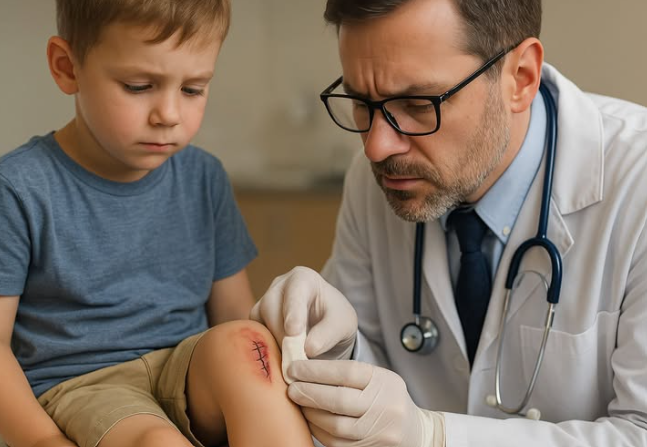Is it normal for your child to get minor cuts and scrapes while running, jumping, or playing? It’s very common. Most of the time, you can clean a small wound like this at home, apply some medicine, and apply a bandage, and it will heal in two to three days. But sometimes, some wounds are more serious, and sometimes they require medical attention and stitches. So, today we’ll talk about exactly what kind of wounds we should be more concerned about, see a doctor, and maybe even get stitches.
🤔 When does a wound need stitches?
Okay, now let’s see what kind of wounds usually require medical treatment, that is, stitches. If your child’s wound has any of these symptoms, it’s best to see a doctor.
1️⃣ Won’t the bleeding stop?
If you have applied pressure to the wound with a clean cloth for about 5 minutes and it still doesn’t stop bleeding, it’s something to be concerned about. Usually, bleeding from a small wound will stop after a while. If it doesn’t stop, there may be a problem with blood clotting, or the wound may be deeper than you think.
2️⃣ Is the wound wide open? (Gaping or Wide)
Are the two sides of the cloth far apart, with a large gap? Does it look like the wound is “gaping”? A wound like this is difficult to heal with home treatment. If this happens, the wound will not heal properly. This can leave a large, unsightly scar. Also, the wound is open, which increases the risk of germs entering and causing infection. Stitching is done to bring the two sides of the wound together and help them heal properly.
3️⃣ Is the wound very deep?
Does the wound seem deeper than it appears on the surface? Sometimes, if you can see the muscles or fat layer underneath the wound, it is definitely a deep wound. These types of wounds also need to be stitched. This is because deep wounds are more likely to become infected if they are not properly cleaned and stitched. Nerves and large blood vessels may also be damaged.
4️⃣ Is the wound on the face, lips, or neck?
If a wound occurs on a sensitive area such as the face, lips, around the eyes, or neck, it is very important to show it to a doctor, even if it is small. Because scars from other wounds in these areas can affect the child’s appearance. Therefore, it is important to stitch the wound according to specialist medical advice to heal it as well as possible and with the least scarring.
5️⃣ Are there any glass fragments or dirt stuck inside the wound?
Sometimes, small pieces of glass, stone chips, wood chips, and dirt can get stuck in a wound. If these are left inside the wound, there is a greater chance of infection, and the wound will not heal properly. It can be difficult to remove all of these at home. A doctor can thoroughly clean the wound, remove the stuck objects, and apply stitches if necessary.
6️⃣ Is there anything sticking out of the wound?
(Ex: a piece of wood)
Sometimes, a wound can have something stuck inside it (for example, a piece of wood, a piece of wire) and part of it can be visible. Please do not try to pull it out! Doing so can cause further damage and increase the bleeding. Take it to a doctor immediately. They will carefully remove it and provide the necessary treatment.
7️⃣ Is the wound bleeding? (Spurts blood)
This is an emergency! If the wound is bleeding like a faucet, it means that a large blood vessel, such as an artery, has been damaged. It is not a good idea to delay at this time.
What to do immediately: Take a clean piece of cloth (a piece of sterile gauze if possible) and place it over the wound and hold it firmly. It is best to keep the wound elevated above the heart (e.g., if it is an arm, keep your arm elevated). Then, as soon as possible, take the child to the Emergency Department (ETU) or the nearest medical center. Do not stop applying pressure to the wound on the way.
These points will help you decide whether or not to stitch a wound. But ultimately, only a doctor can tell you for sure whether your child needs stitches or other treatment. Therefore, if you have any doubts, it is safest to see a doctor and get advice.
🩹 If your child needs stitches…
Before stitching, doctors will thoroughly clean the wound, as this is very important to prevent infection. It is also your responsibility to take good care of the wound at home after stitching.
❤️🩹 How do you care for a stitched wound?
- Follow the doctor’s instructions exactly: The doctor will explain to you how to keep the wound clean after the stitches are placed, when you can bathe, what creams to apply, and when to come back for stitches. Follow those instructions exactly.
- Keep the wound clean and dry: Clean the wound as your doctor tells you. Usually, they will tell you to clean it daily and put on a new bandage. Do not let the wound get wet.
- Watch for signs of infection:
- Is there redness and swelling around the wound?
- Is there yellow or green pus coming out of the wound?
- Does the child have unbearable pain when touching the wound?
- Does the wound feel hot?
- Does the child have a fever?
If any of these symptoms are present, see a doctor immediately. It could be a sign of infection. - Do not play with the stitches: Do not let the child scratch the wound or pull on the stitches. If this happens, the stitches may break and the wound may reopen.
- Cut the stitches on the scheduled date: Go and cut the stitches on the day the doctor tells you. It is also not good to keep the stitches in for a long time.
💉 Remember about the tetanus vaccine!
When you get an injury, especially if you come into contact with things like dirt and rust, there is a risk of developing a dangerous disease called tetanus. Check to see if your child has been given tetanus vaccinations according to the scheduled schedule. If in doubt, ask the doctor about it when you go to get the wound treated. The doctor may decide to give an additional tetanus booster.
🏠 How to take care of a minor wound at home
You don’t need to run to the doctor for every minor scrape or wound. For a small, superficial wound, you can take care of it at home by:
1️⃣ Wash your hands: Wash your hands thoroughly with soap and water before touching the wound. Otherwise, germs from your hands can be transferred to the wound.
2️⃣ Stop the bleeding: Apply pressure to the wound with a clean cloth or gauze. The bleeding should stop in a few minutes.
3️⃣ Wash the wound: After the bleeding stops, wash the wound thoroughly with clean water (warm water is best) and a mild soap. Wash until all dirt and debris around the wound is removed. Do not get soap into the wound.
4️⃣ Apply an antibiotic ointment: After the wound has healed, you can apply a thin layer of an antibiotic ointment prescribed by a doctor. This will help prevent infection.
5️⃣ Cover the wound: Cover the wound with a clean bandage or gauze. This will keep the wound clean and prevent it from getting worse. Change the bandage daily, or if it gets wet or dirty.
Remember, if the wound looks large, deep, or if you have any doubts, it is wise to see a doctor rather than trying to treat it at home.
💡 Most importantly: Trust your instincts!
As a mother or father, you have a good understanding of your child. If you look at a wound and think, “This looks a little strange,” let that feeling go. Don’t be afraid to go to the doctor and say, “Look at this, Doctor/Miss, I’m a little suspicious.” It may not be anything serious. But it will be a relief to have that suspicion cleared up.
📝 Finally, Take-Home Message
- If the bleeding does not stop within 5 minutes, if the wound is open, deep, on the face/neck, has dirt trapped inside, or is oozing blood, seek medical attention immediately.
- A bleeding wound (spurting blood) is an emergency! Immediately apply pressure with a clean cloth and take it to a hospital.
- If you have a wound, also consider getting a tetanus shot.
- After stitches, follow the doctor’s instructions exactly and watch for signs of infection.
- If you have any doubts, do not hesitate to see a doctor. The safety of the child is the most important thing.
So, I hope these things have been useful to you. Although it is impossible to prevent minor accidents in children, it is very important to know how to treat them properly.





